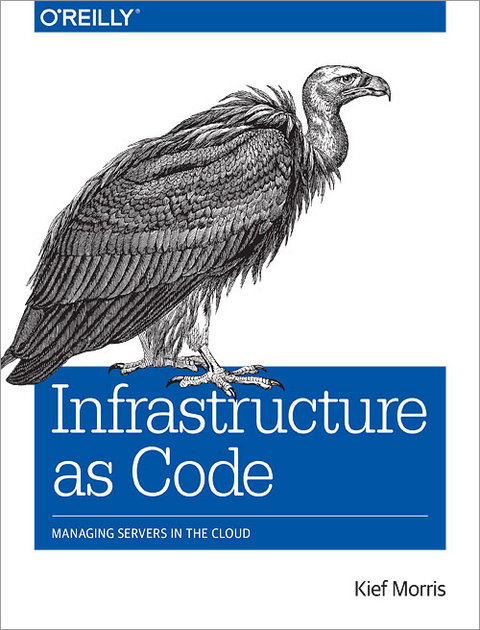
Infrastructure as Code
O'Reilly Media (Verlag)
978-1-4919-2435-8 (ISBN)
- Titel ist leider vergriffen;
keine Neuauflage - Artikel merken
But many organizations adopting these technologies have found that it only leads to a faster-growing sprawl of unmanageable systems.
This is where infrastructure as code can help. With this practical guide, author Kief Morris of ThoughtWorks shows you how to effectively use principles, practices, and patterns pioneered through the DevOps movement to manage cloud age infrastructure.
Ideal for system administrators, infrastructure engineers, team leads, and architects, this book demonstrates various tools, techniques, and patterns you can use to implement infrastructure as code.
In three parts, you’ll learn about the platforms and tooling involved in creating and configuring infrastructure elements, patterns for using these tools, and practices for making infrastructure as code work in your environment.
- Examine the pitfalls that organizations fall into when adopting the new generation of infrastructure technologies
- Understand the capabilities and service models of dynamic infrastructure platforms
- Learn about tools that provide, provision, and configure core infrastructure resources
- Explore services and tools for managing a dynamic infrastructure
- Learn specific patterns and practices for provisioning servers, building server templates, and updating running servers
Kief Morris has been designing, building, and running automated IT server infrastructure for nearly twenty years, having started out with shell scripts and Perl, moving on to CFengine, Puppet, Chef, and Ansible among other technologies as they've emerged. He is the head of ThoughtWorks' European practice for Continuous Delivery and DevOps, helping clients find more effective ways of building and managing infrastructure operations.
Foundations
Chapter 1Challenges and Principles
Why Infrastructure as Code?
What Is Infrastructure as Code?
Challenges with Dynamic Infrastructure
Principles of Infrastructure as Code
Practices
Antifragility: Beyond “Robust”
Conclusion
What’s Next?
Chapter 2Dynamic Infrastructure Platforms
What Is a Dynamic Infrastructure Platform?
Requirements for a Dynamic Infrastructure Platform
Infrastructure Resources Provided by the Platform
Types of Dynamic Infrastructure Platforms
Deciding on a Dynamic Infrastructure Platform
Mechanical Sympathy with the Cloud and Virtualization
Conclusion
Chapter 3Infrastructure Definition Tools
Choosing Tools for Infrastructure as Code
Configuration Definition Files
Working with Infrastructure Definition Tools
Configuration Registries
Conclusion
Chapter 4Server Configuration Tools
Goals for Automated Server Management
Tools for Different Server Management Functions
Server Change Management Models
Containers
Conclusion
Chapter 5General Infrastructure Services
Considerations for Infrastructure Services and Tools
Sharing a Service Between Teams
Monitoring: Alerting, Metrics, and Logging
Service Discovery
Distributed Process Management
Software Deployment
Conclusion
Patterns
Chapter 6Patterns for Provisioning Servers
Server Provisioning
Patterns for Creating Servers
Patterns for Bootstrapping New Servers
Conclusion
Chapter 7Patterns for Managing Server Templates
Stock Templates: Can’t Someone Else Do It?
Provisioning Servers Using Templates
The Process for Building a Server Template
Origin Images
Updating Server Templates
Building Templates for Roles
Automating Server Template Management
Conclusion
Chapter 8Patterns for Updating and Changing Servers
Models for Server Change Management
General Patterns and Practices
Patterns and Practices for Continuous Deployment
Patterns and Practices for Immutable Servers
Practices for Managing Configuration Definitions
Conclusion
Chapter 9Patterns for Defining Infrastructure
Environments
Organizing Infrastructure
Running Definition Tools
Conclusion
Practices
Chapter 10Software Engineering Practices for Infrastructure
System Quality
VCS for Infrastructure Management
Continuous Integration (CI)
Continuous Delivery (CD)
Code Quality
Managing Major Infrastructure Changes
Conclusion
Chapter 11Testing Infrastructure Changes
The Agile Approach to Testing
Structuring the Test Suite: The Test Pyramid
Implementing a Balanced Test Suite
Managing Test Code
Roles and Workflow for Testing
Conclusion
Chapter 12Change Management Pipelines for Infrastructure
Benefits of a Change Management Pipeline
Guidelines for Designing Pipelines
Basic Pipeline Designs
Practices for Using a Pipeline
Scaling Pipelines to More Complex Systems
Techniques for Handling Dependencies Between Components
Practices for Managing Interfaces Between Components
Conclusion
Chapter 13Workflow for the Infrastructure Team
Automate Anything That Moves
Using a Local Sandbox
Codebase Organization Patterns
Workflow Effectiveness
Conclusion
Chapter 14Continuity with Dynamic Infrastructure
Service Continuity
Zero-Downtime Changes
Data Continuity
Disaster Recovery
Security
Conclusion
Chapter 15Organizing for Infrastructure as Code
Evolutionary Architecture
Measuring Effectiveness
Organize to Empower Users
Governance through Continuous Change Management
Conclusion: It’s Never Finished
| Erscheint lt. Verlag | 26.7.2016 |
|---|---|
| Verlagsort | Sebastopol |
| Sprache | englisch |
| Maße | 150 x 250 mm |
| Gewicht | 666 g |
| Einbandart | kartoniert |
| Themenwelt | Mathematik / Informatik ► Informatik ► Netzwerke |
| Informatik ► Software Entwicklung ► SOA / Web Services | |
| Informatik ► Software Entwicklung ► Software Architektur | |
| Informatik ► Weitere Themen ► Hardware | |
| Schlagworte | Cloud • Code • IAC • Infrastructure • Netzwerke • Server • Systemadministration |
| ISBN-10 | 1-4919-2435-7 / 1491924357 |
| ISBN-13 | 978-1-4919-2435-8 / 9781491924358 |
| Zustand | Neuware |
| Haben Sie eine Frage zum Produkt? |
aus dem Bereich


